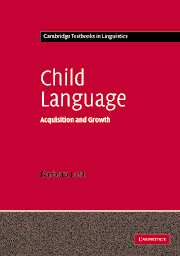Book contents
- Frontmatter
- Contents
- List of figures
- List of tables
- Preface
- Acknowledgements
- 1 The Growth of language
- 2 What is acquired?
- 3 What is the problem of language acquisition?
- 4 How we can construct a theory of language acquisition
- 5 Brain and language development
- 6 The nature of nurture
- 7 How can we tell what children know? Methods for the study of language acquisition
- 8 The acquisition of phonology
- 9 The acquisition of syntax
- 10 The acquisition of semantics
- 11 On the nature of language growth
- 12 Conclusions: toward an integrated theory of language acquisition
- Appendices
- 1 Developmental milestones in motor and language development (adapted from Lenneberg 1967)
- 2a Developmental milestones in infant speech perception
- 2b Examples of sound distinctions perceived by infants
- 3 Developmental milestones in infant speech production
- 4 Developmental milestones in infant syntax: perception
- 5 Developmental milestones in infant syntax: production
- 6 Developmental milestones in infant semantics
- 7 Abbreviations and notations
- Glossary
- References
- Author index
- Subject index
12 - Conclusions: toward an integrated theory of language acquisition
Published online by Cambridge University Press: 05 June 2012
- Frontmatter
- Contents
- List of figures
- List of tables
- Preface
- Acknowledgements
- 1 The Growth of language
- 2 What is acquired?
- 3 What is the problem of language acquisition?
- 4 How we can construct a theory of language acquisition
- 5 Brain and language development
- 6 The nature of nurture
- 7 How can we tell what children know? Methods for the study of language acquisition
- 8 The acquisition of phonology
- 9 The acquisition of syntax
- 10 The acquisition of semantics
- 11 On the nature of language growth
- 12 Conclusions: toward an integrated theory of language acquisition
- Appendices
- 1 Developmental milestones in motor and language development (adapted from Lenneberg 1967)
- 2a Developmental milestones in infant speech perception
- 2b Examples of sound distinctions perceived by infants
- 3 Developmental milestones in infant speech production
- 4 Developmental milestones in infant syntax: perception
- 5 Developmental milestones in infant syntax: production
- 6 Developmental milestones in infant semantics
- 7 Abbreviations and notations
- Glossary
- References
- Author index
- Subject index
Summary
Are you having trouble
in saying this stuff?
It's really quite easy for me.
I just look in my mirror
and see what I say,
and then I just say what I see.
(Seuss, 1979)Introduction
Our review of research in the basic areas of language acquisition has led us to several conclusions regarding our fundamental question: how does a child acquire language?
They lead us to overturn several common myths about language acquisition. While they do not directly provide us with a full theory of language acquisition, they allow us to lay the foundations for a future theory, one which can link both linguistic and developmental approaches. In this chapter, we will first summarize fundamental generalizations that emerge from the research we have reviewed; next, we will identify remaining open questions and sketch a framework which we consider promising for future research.
Conclusions
(A) We have seen that the course of language acquisition begins at birth, if not before, and proceeds continuously through the first few years of life. There is no “prelinguistic” stage. Although language acquisition is commonly thought to begin with children's first produced words, we have seen that the first words are the culmination of previous, complex language development. Contrary to a common assumption, words are not the “building blocks” of language acquisition, but develop in parallel to acquisition of the formal system of language, and in part as a result of this. […]
- Type
- Chapter
- Information
- Child LanguageAcquisition and Growth, pp. 263 - 269Publisher: Cambridge University PressPrint publication year: 2006

